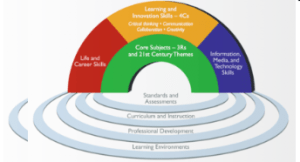 The four C’s
The four C’s
Critical Thinking
Communication
Creativity
Collaboration
Critical thinking is essential for our young people as it is the skills needed to be successful across learning areas. It is essential for our young readers and learners to be active and participant learners. One of the foundations of building critical thinking is by following the Four C’s which are critical thinking, communication, creativity and collaboration.
We are now living in an era of digital technology. It’s important that we teach our children not only to be safe on the internet, but to be thinking continuously and be aware of what they are seeing rather than going ahead with their finger tips. In order to be successful at living and learning in a digital world, we need to build smart digital skills for our learners so they can be smart learners and be smart media. This means they need to be critically thinking in the print world and digital world. A lot of teachers are already doing this in their classrooms either through reading or an integrated curriculum rather than a stand alone lesson on Cyber Smart. Adults can be easily misled on the internet. So with our tamariki we need to be more careful and start building them to be a smart digital literate where they can determine fake information from real facts. An example below will show you two different sites that advertise fake information.


There are three levels of thinking: Literal, interpretive and evaluative. Today’s discussion on Higher Order of Thinking gave me tips on how I can implement more of interpretive and evaluative thinking. Sometimes we launch a discussion with children before going over the STEM for our provocation. I need to remember that students need time to build critical thinking and not expect them to have it on the top of their heads. A way to solve this problem is to have children pre-read their journals before coming down for their guided reading.  It will help children build some knowledge around the texts. With this students are more prepared for discussion where I can use provocation statements to help tamariki think evaluatively. Here they can reason with each other on their perspectives while building to a better truth. Everybody can have their perspective. But using critical thinking means that everybody can agree to the best perspectives. We want kids to understand that there is a better truth. Reason to the best possible conclusion. We need to build capability with our tamariki and give them the tools to challenge group thinking. Allowing them to reason with each other to evaluate and come to a better truth.
It will help children build some knowledge around the texts. With this students are more prepared for discussion where I can use provocation statements to help tamariki think evaluatively. Here they can reason with each other on their perspectives while building to a better truth. Everybody can have their perspective. But using critical thinking means that everybody can agree to the best perspectives. We want kids to understand that there is a better truth. Reason to the best possible conclusion. We need to build capability with our tamariki and give them the tools to challenge group thinking. Allowing them to reason with each other to evaluate and come to a better truth.